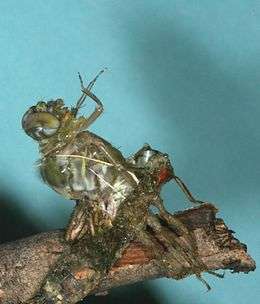Moulting
In biology, moulting (British English), or molting (American English), also known as sloughing, shedding, or in many invertebrates, ecdysis, is the manner in which an animal routinely casts off a part of its body (often, but not always, an outer layer or covering), either at specific times of the year, or at specific points in its life cycle.
Moulting can involve shedding the epidermis (skin), pelage (hair, feathers, fur, wool), or other external layer. In some groups, other body parts may be shed, for example, wings in some insects or the entire exoskeleton in arthropods.
Examples
| Group | Item shed | Timing | Notes |
|---|---|---|---|
| Cats | Fur | Usually around spring-summer time | Cats moult fur around spring-summer time to get rid of their "winter coat". Cats have thicker fur during the colder winter months to keep them warm, then around spring and summer they shed some of their fur to get a thinner coat for the warmer summer months. Some cats need brushing during moulting, since dead hairs can get trapped in the cat's fur. |
| Chicken | Feathers | Usually autumn (non-commercial hens). | Chickens generally stop laying eggs when their moulting begins and recommence laying when their new feathers have re-grown. |
| Dogs and other canids | Fur | Semi-annually, spring and fall (autumn). | Moulting or shedding in canids, as in all mammals,[1] is due to fluctuations in the amount of melatonin secreted by their pineal gland in response to seasonal sunlight variations rather than temperature variations. This seasonality in moulting is most preserved in Arctic breeds of dogs which shed twice each year whereas most other breeds moult once each year. |
| Snakes | Skins | Regularly, when old skin is outgrown. | Snakes rub against rough surfaces to assist removal of their shed skin. |
| Lizards | Skin | Regularly, when old skin is outgrown. | Lizards, like snakes, rub against objects to help remove their shed skin and then consume the shed skin for calcium and other nutrients. |
| Hermit crabs | Exoskeleton | Regularly, when the carapace is outgrown. | Land hermit crabs bury themselves for many weeks while they moult and then consume their exoskeleton. |
| Amphibians | Skin | Regularly. | Salamanders and frogs shed their skins regularly, then often eat it. |
| Arachnids | Exoskeleton | Regularly, when the exoskeleton is outgrown. | Arachnids moult regularly to grow, often becoming reclusive and fasting for long periods prior to a moult. |
| Insects | Exoskeleton | Regularly in larvae, when the exoskeleton is outgrown. | In species with a "complete" metamorphosis, the final moult transforms the body, typically from a soft-bodied larva to a reproductive, winged and sometimes colourful adult. In mayflies, a winged subimago moults one last time to a winged adult. |
In birds
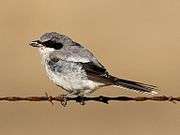 |
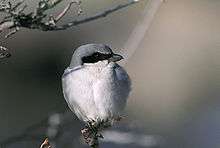 |
| A loggerhead shrike in mid-moult (left) and with regular plumage (right). | |
%E2%80%93King_penguin_(Aptenodytes_patagonicus)_05.jpg)
In birds, moulting is the periodic replacement of feathers by shedding old feathers while producing new ones. Feathers are dead structures at maturity which are gradually abraded and need to be replaced. Adult birds moult at least once a year, although many moult twice and a few three times each year.[2] It is generally a slow process as birds rarely shed all their feathers at any one time; the bird must retain sufficient feathers to regulate its body temperature and repel moisture. The number and area of feathers that are shed varies. In some moulting periods, a bird may renew only the feathers on the head and body, shedding the wing and tail feathers during a later moulting period.[2] Some species of bird become flightless during an annual "wing moult" and must seek a protected habitat with a reliable food supply during that time. While the plumage may appear thin or uneven during the moult, the bird's general shape is maintained despite the loss of apparently many feathers; bald spots are typically signs of unrelated illnesses, such as gross injuries, parasites, feather pecking (especially in commercial poultry), or (in pet birds) feather plucking. Some birds will drop feathers, especially tail feathers, in what is called a "fright moult".[3]
The process of moulting in birds is as follows: First, the bird begins to shed some old feathers, then pin feathers grow in to replace the old feathers. As the pin feathers become full feathers, other feathers are shed. This is a cyclical process that occurs in many phases. It is usually symmetrical, with feather loss equal on each side of the body.[2] Because feathers make up 4–12% of a bird's body weight, it takes a large amount of energy to replace them. For this reason, moults often occur immediately after the breeding season, but while food is still abundant. The plumage produced during this time is called postnuptial plumage.[2] Prenuptial moulting occurs in red-collared widowbirds where the males replace their nonbreeding plumage with breeding plumage. It is thought that large birds can advance the moult of severely damaged feathers.[4]
Determining the process birds go through during moult can be useful in understanding breeding, migration and foraging strategies. [5] One non-invasive method of studying moult in birds is through using field photography. [6] The evolutionary and ecological forces driving moult can also be investigated using intrinsic markers such as stable hydrogen isotope (δ2H) analysis. [7] In some tropical birds, such as the common bulbul, breeding seasonality is weak at the population level, instead moult can show high seasonality with individuals probably under strong selection to match moult with peak environmental conditions.[8]
Forced moulting
In some countries, flocks of commercial layer hens are force-moulted to reinvigorate egg-laying. This usually involves complete withdrawal of their food and sometimes water for 7–14 days or up to 28 days under experimental conditions,[9] which presumably reflect standard farming practice in some countries. This causes a body weight loss of 25 to 35%,[10] which stimulates the hen to lose her feathers, but also reinvigorates egg-production. Some flocks may be force-moulted several times. In 2003, more than 75% of all flocks were force-moulted in the US.[11] Other methods of inducing a moult include low-density diets (e.g. grape pomace, cotton seed meal, alfalfa meal)[12] or dietary manipulation to create an imbalance of a particular nutrient(s). The most important among these include manipulation of minerals including sodium (Na), calcium (Ca), iodine (I) and zinc (Zn), with full or partially reduced dietary intakes.[13]
In reptiles
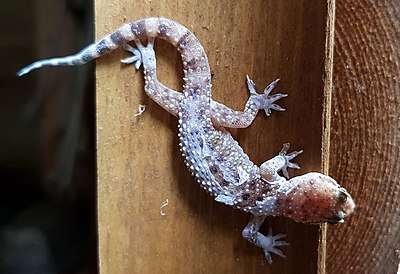
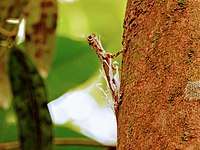 | |
| Close up view of snake's moulted skin (left) and a black-bearded gliding lizard moulting (right). | |
The most familiar example of moulting in reptiles is when snakes "shed their skin". This is usually achieved by the snake rubbing its head against a hard object, such as a rock (or between two rocks) or piece of wood, causing the already stretched skin to split. At this point, the snake continues to rub its skin on objects, causing the end nearest the head to peel back on itself, until the snake is able to crawl out of its skin, effectively turning the moulted skin inside-out. This is similar to how one might remove a sock from one's foot by grabbing the open end and pulling it over itself. The snake's skin is often left in one piece after the moulting process, including the discarded brille (ocular scale), so that the moult is vital for maintaining the animal's quality of vision. The skins of lizards, in contrast, generally fall off in pieces.
In arthropods
In arthropods, such as insects, arachnids and crustaceans, moulting is the shedding of the exoskeleton (which is often called its shell), typically to let the organism grow. This process is called ecdysis. It is commonly said that ecdysis is necessary because the exoskeleton is rigid and cannot grow like skin, but this is simplistic, ignoring the fact that most Arthropoda with soft, flexible skins also undergo ecdysis. Among other things, ecdysis permits metamorphosis, the sometimes radical difference between the morphology of successive instars, and the fact that a new skin can replace structures, such as by providing new external lenses for eyes. The new exoskeleton is initially soft but hardens after the moulting of the old exoskeleton. The old exoskeleton is called an exuviae. While moulting, insects can't breathe.[14]
In dogs
Most dogs moult twice each year, in the spring and autumn, depending on the breed, environment and temperature. Dogs shedding much more than usual are known as "blow coats" or "blowing coats".[15][16]
In amphibians
Both frogs and salamanders moult regularly and consume the skin, with some species moulting in pieces and others in one piece.[17]
Gallery
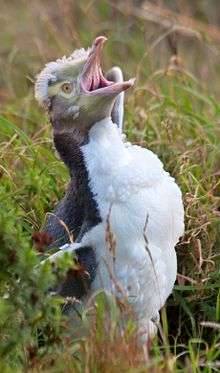 A moulting yellow-eyed penguin.
A moulting yellow-eyed penguin.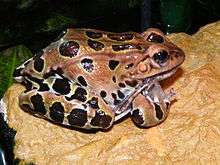 A leopard frog moulting and eating the skin.
A leopard frog moulting and eating the skin.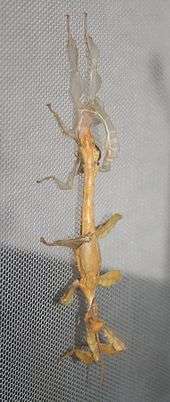 Giant prickly stick insect crawling out of his moulted skin.
Giant prickly stick insect crawling out of his moulted skin.- Moulted snake skin.
- Moulting European green lizard.
 Discarded moult of a grasshopper (Caelifera).
Discarded moult of a grasshopper (Caelifera).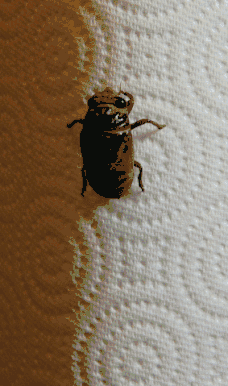 A cicada moulting.
A cicada moulting.
References
- Lincoln, G. A.; Clarke, I. J.; Hut, R. A.; Hazlerigg, D. G. (2006). "Characterizing a mammalian circannual pacemaker". Science. 314 (5807): 1941–4. doi:10.1126/science.1132009. PMID 17185605.
- Terres, J. K. (1980). The Audubon Society Encyclopedia of North American Birds. New York, NY: Knopf. pp. 616–617. ISBN 978-0-394-46651-4.
- Lindström, A.; Nilsson, J.Å. (1988). "Birds doing in the octopus way: Fright moulting and distraction of predators". Ornis Scandinavica. 19 (2): 165–166. doi:10.2307/3676468. JSTOR 3676468.
- Ellis, D. H.; Rohwer, V. G.; Rohwer, S. (2017). "Experimental evidence that a large raptor can detect and replace heavily damaged flight feathers long before their scheduled moult dates". Ibis. 159 (1): 217–220. doi:10.1111/ibi.12416.
- Newton, I. (2011). "Moult and plumage". Ringing & Migration. 24 (3): 220–226. doi:10.1080/03078698.2009.9674395.
- Vieira, B. P.; Furness, R. W.; Nager, R. G. (2017). "Using field photography to study avian moult" (PDF). Ibis. 159 (2): 443–448. doi:10.1111/ibi.12445.
- Chabot, A. A.; Hobson, K. A.; Criag, S.; Lougheed, S. C. (2018). "Moult in the Loggerhead Shrike Lanius ludovicianus is influenced by sex, latitude and migration". Ibis. 160 (2): 301–312. doi:10.1111/ibi.12551.
- Nwaogu, C.J.; Tieleman, B.I.; Cresswell, W. (2019). "Weak breeding seasonality of a songbird in a seasonally arid tropical environment arises from individual flexibility and strongly seasonal moult". Ibis. 161 (3): 533–545. doi:10.1111/ibi.12661.
- Molino, A.B., Garcia, E.A., Berto, D.A., Pelícia, K., Silva, A.P. and Vercese F. (2009). "The effects of alternative forced-molting methods on the performance and egg quality of commercial layers". Revista Brasileira de Ciência Avícola. 11 (2): 109–113. doi:10.1590/S1516-635X2009000200006.CS1 maint: multiple names: authors list (link)
- Webster, A.B. (2003). "Physiology and behavior of the hen during induced moult". Poultry Science. 82 (6): 992–1002. doi:10.1093/ps/82.6.992. PMID 12817455.
- Yousaf, M. & Chaudhry, A.S. (2008). "History, changing scenarios and future strategies to induce moulting in laying hens". World's Poultry Science Journal. 64: 65–75. doi:10.1017/S0043933907001729.
- Patwardhan, D. & King, A. (2011). "Review: feed withdrawal and non feed withdrawal moult". World's Poultry Science Journal. 67 (2): 253–268. doi:10.1017/S0043933911000286.
- Khan, R.U., Nikousefat, Z., Javdani, M., Tufarelli, V. and Laudadio, V. (2011). "Zinc-induced moulting: production and physiology". World's Poultry Science Journal. 67 (3): 497–506. doi:10.1017/S0043933911000547.CS1 maint: multiple names: authors list (link)
- Stokstad, Erik (29 August 2014). "Insect molting is 'like having your lungs ripped out'". sciencemag.org. Retrieved 1 September 2014.
- Blackburn, Sandy (2008). [I https://books.google.com/books?id=r_LsDQAAQBAJ&pg=PT110&dq=blowing+coat The Everything Dog Grooming Book: All you need to help your pet look and feel great!] Check
|url=value (help). Avon, Massachusetts: Simon & Schuster. p. 110. ISBN 978-1440512148. Retrieved 2017-07-04. - Dog Fancy (2011). Pug. New York: Lumina Media. p. 36. ISBN 978-1593788391. Retrieved 2017-07-04.
- Frost, S. W. (1932). "Notes on feeding and molting in frogs". The American Naturalist. 66 (707): 530–540. doi:10.1086/280458. JSTOR 2456779.
External links
| Wikimedia Commons has media related to Moult. |
